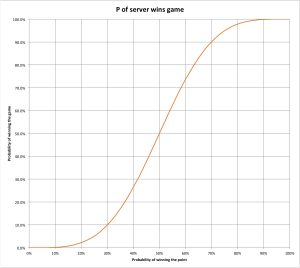In an earlier post we discussed the probability of winning a game if you know the probability of winning a point. This is the math behind the formula.
The complicated part of the calculation is that a game of tennis can go over deuce many times, even indefinitely (in theory, at least). We will therefore treat the deuce part and the no-deuce part separately.
Mathematically speaking, the probability of winning a game is the probability of winning without deuce plus the probability of winning with deuce
(since these are disjoint events).
Recall that is the probability of winning a single point.
consists of winning the point after 40-0, 40-15 or 40-30. The question now is how many ways of getting to 40-0, 40-15 or 40-30 are there? The first one (40-0) is easy, there is only one way: 15-0, 30-0, 40-0. The second one is more difficult, as there are already 4 different ways: (1) 15-0, 30-0, 40-0, 40-15, (2) 15-0, 30-0, 30-15, 40-15, (3) 15-0, 15-15, 30-15, 40-15, and (4) 0-15, 15-15, 30-15, 40-15.
Generally, this kind of problem is known as the number of possible selections of elements amongst a set of
elements, written as
. In the context of our problem,
is the number of points played and
is the number of points your opponent scores. Equivalently,
can be seen as the number of points you will score, which is always
(you need
points to reach 40-?). So there are
ways of reaching 40-?. The interpretation is that in a series of
points played, you can select any
points among them in order to get to 40-?.
The probability of e.g. winning the game after 40-15 is times the probability of reaching 40-15. The probability of reaching 40-15 is
, as you have to score
points (
) and your opponent scores one point (
). So winning after 40-15 is as probable as
.
Putting it all together for the three different cases (40-0, 40-15, 40-30), we get
. Simplified, this is
and
We have got part one of . Part two has two main components, the probability of getting to deuce (
) and the probability of winning at deuce (
). In order to get
, these two components can simply be multiplied (
).
The probability of getting to deuce is , as
points have to be played,
of which either player has to win (this is the number of ways getting to 40-40) times the probability of winning three points each (
,
respectively).
The probability of winning a game at deuce is a function of winning two points in a row, plus winning only one point each (which is deuce again) and winning the game from there. This is the formula: . This resolves to
.
We get
Putting it all together, we get the formula we have been looking for:
For , the function plots like this:

